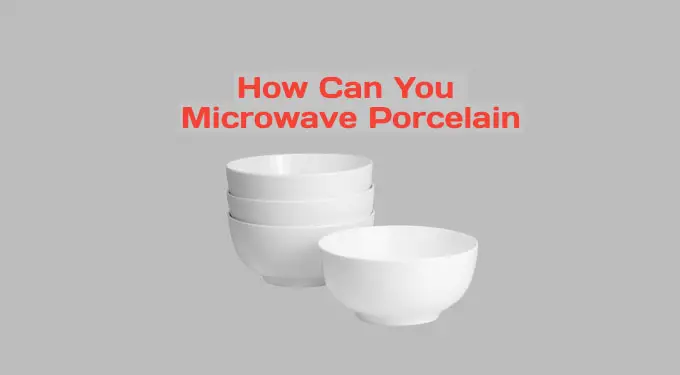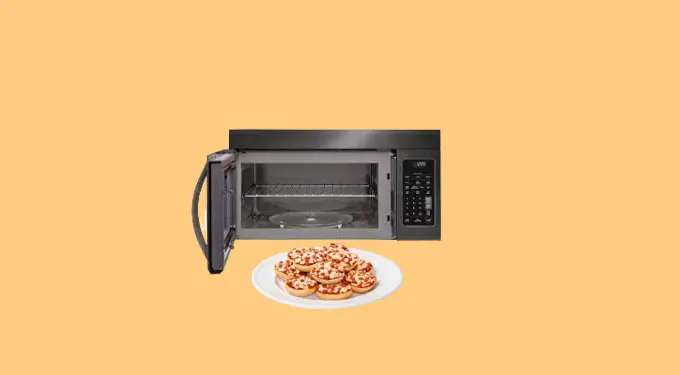At the top of household items that can break in the microwave, you’ll likely find porcelain. But does that mean you should never put your beautiful plates or bowls in the microwave? I’d be damned if I’d stop using my favorite mug just because I can’t microwave it. With a little bit of care, you can learn how to safely microwave porcelain.
One of the best ways to make the most out of your microwave oven is to use it to heat porcelain. If you are looking for an easy and efficient way to do this, we will also look into some tips on how you can make sure that your porcelain is microwave-safe.
Are porcelain plates microwave safe?
Porcelain is a type of traditional ceramic that is made from a mix of kaolin clay, feldspar, and quartz sand. The clay is placed in a kiln and heated to firing temperatures between 2200 and 2600 degrees Fahrenheit. During this process, the clay undergoes chemical changes that give porcelain its characteristic white color and translucent appearance. Finally, the porcelain is cooled and polished to create a smooth, glossy finish.
When it comes to microwave safety, there are a few things to keep in mind. Some materials, like glass and porcelain, can withstand high temperatures without issue. But when you consider the source of heat, i.e. microwave radiation, some heat-resistant materials automatically fall off the list. Porcelain is one of the few that can stand hot oven heat as well as microwave radiation, after all, the firing process entails more extreme temperatures than a microwave can achieve.
When microwaving porcelain, you ought to check for any metallic finishes or handles which can spell disaster in the microwave. Even a metal lining on the rim of a plate can cause arcing (sparks) in the microwave. Any damage to the porcelain will also make it more susceptible to breaking in the microwave due to sudden heating and thus expansion.
Microwavable ceramics
Generally, traditional ceramic materials, including porcelain, earthenware, and stoneware dishes, are considered safe for microwaving as long as it doesn’t have any metal trim or decorations. So, if your porcelain has any gold or silver decorations, reserve it for serving food, not reheating in the microwave.
There is also a fair chance that the label on your porcelain set will indicate whether or not it is microwave-safe. This is the best way to tell whether those decorations are metallic (non-microwavable) or not.
are ceramics microwave safe
Absolutely, ceramics are usually safe for the microwave. But it’s essential to be cautious. Check for any metal elements or glazes with lead or other metals. Stick to ceramics labeled as microwave-safe and avoid rapid temperature shifts to prevent cracks. Always follow the manufacturer’s instructions for safe microwave use.
Does porcelain get hot in the microwave?
Porcelain is an excellent conductor of heat, which is why it’s often used to make cookware. So, it stands to reason that porcelain would get just as hot in the microwave as it would on a stovetop.
Unlike the food being reheated, porcelain has no water molecules that would interact with the microwave radiation to produce heat. All the heat perceived on the porcelain is due to conduction from the food itself.
For this reason, you should always use caution when removing porcelain from the microwave. Use potholders, or better yet, oven mitts, to avoid burns. And be sure to place the hot porcelain on a heat-safe surface to avoid damaging your countertops or tables.
What happens when you put porcelain in the microwave?
Porcelain is a microwave-safe material, meaning that it won’t get hot in the microwave and won’t be damaged by the microwaves. However, if you put porcelain in the microwave, it can get hot from the food. If you have a porcelain plate that’s been in the microwave, let it cool down before you touch it.
Decorated porcelain is susceptible to microwave damage if the decorations are metallic. If you have porcelain with metallic paint or other decorations, use an alternate microwave-safe dish to nuke your food.
How long can you microwave porcelain?
Porcelain is a type of ceramic that is made from kaolin, a white clay. During the manufacturing process, it is fired at maximum temperatures, which gives it a hard, glossy surface. Porcelain is often used to make dinnerware, figurines, and bathroom fixtures. While it is microwave-safe, there are some risks associated with microwaving porcelain.
For example, if there are pre-existing cracks, the sudden heating in the microwave oven causes a thermal shock which could extend the cracks. For this reason, you shouldn’t microwave porcelain for longer than 10 minutes at a go, even though perfect porcelain can withstand the entire attainable microwave range of temperatures.
How do you microwave porcelain?
Porcelain is characterized by a smooth, white surface. It is a popular material for making dinnerware and other household items because it is durable and easy to clean. However, porcelain can also be delicate, and it is important to take care when microwaving it.
The following tips will help you microwave porcelain safely:
- Check the label:
Always check the label to see if your porcelain is microwave-safe. If it is, place the dish in the microwave on any setting and heat for the recommended time. If your porcelain is not microwave-safe, find an alternate microwavable dish.
- Inspect the porcelain physically:
Inspect the porcelain for any metallic paint or other decorations before microwaving. If there are any metallic accents, do not microwave them. The microwaves will cause the metal to arc and spark and could start a fire.
- Don’t microwave cracked porcelain:
Ensure your porcelain has no cracks or chips before microwaving. The sudden temperature change could cause these imperfections to worsen.
- Go easy for the initial microwaving:
If you are microwaving porcelain for the first time, start with a short time, such as 30 seconds. If everything goes well, you can increase the time in subsequent reheatings. Once you’ve established the porcelain is just fine, you can reheat foods for an extended period without any worries.
- Handle hot porcelain with care:
Porcelain is a good conductor of heat, so be careful when handling it after microwaving. Use oven mitts or potholders to avoid burns.
By following the above tips, you can safely and effectively reheat your food in a porcelain dish.
Frequently Asked Questions:
What bowls are microwave safe?
Before microwaving any type of bowl, it is important to check that it is safe to use in this appliance. porcelain, earthenware, stoneware, and traditional ceramic plates are all safe to use in the microwave. However, bowls made with metal or plastic should not be microwaved. If you are unsure whether a bowl is microwave safe, it is best not to use it in this appliance. After all, there are already so many different types of microwave-safe bowls available, and thus no need to take unnecessary risks.
Can you put a porcelain mug in the microwave?
Yes, you can put a porcelain mug in the microwave. Just make sure that the mug is labeled microwave-safe. You can also tell if a porcelain mug is microwave-safe if it lacks any shiny (gold/silver) decorations and is a solid white color. If you are unsure, it is always best to use alternative microwavable dishes.
Unlike plastic containers that can leach harmful chemicals into the food, ceramic dishes are your best option in the microwave.
Is porcelain microwave and dishwasher safe?
Most porcelain is dishwasher and microwave safe. However, if the porcelain is decorated with either gold or platinum, do not put it in the dishwasher or the microwave. The dishwasher would most likely damage or scratch the decoration on your precious dinnerware sets, while the microwave would pose a risk of fire from arcing.
Final Thoughts:
While porcelain is a great material for many household items, it is important to take care when microwaving it. We’ve seen that with the right precautions, you can safely reheat your food in a porcelain dish. The most important thing to remember is that metallic objects or decorations should never be microwaved.



